hankyoreh
Links to other country sites 다른 나라 사이트 링크
[Korea travels] In search of Seoul’s best tonkatsu – a universal favorite made unique

Catsu, a restaurant in the Sinsu neighborhood of Seoul’s Mapo District, is a difficult place to visit in several regards.
To begin with, there’s the location, which isn’t exactly subway-adjacent. The closest stop is Gwangheungchang Station on Line 6 of the Seoul Subway, and Naver Maps calculates it as a 10-minute walk if you stick to main roads.
The operating hours are also “fluid.” Recently, the restaurant has only been open during lunchtime hours because the chef’s dog has been sick. Even then, you should check the eatery’s Instagram page before making the trek.
In terms of size, it’s pretty tiny: seven seats in all. Yet on Monday, Nov. 28, Catsu had a line of people waiting for seats even after lunchtime had passed.
There are a few reasons for this. Most basically, the food is delicious. Like a top-flight soccer team, Catsu’s tonkatsu (fried pork cutlet) has no weak links. The sirloin and tenderloin are exquisitely fried, bringing out the juiciness of the meat without any gamey flavor.
The fermented soybean soup — doenjangguk — served on the side has enough solid ingredients that it could be sold separately as a meal. The cabbage is sliced finely like chives, the rice scooped fresh from the cooker each time.
The welcome is friendly enough, even if the staff seem a bit shy. The restaurant is only open at lunchtime, and you should check social media before you go. You’ll have to stand in line, but that’s all right — the flavor is worth it.
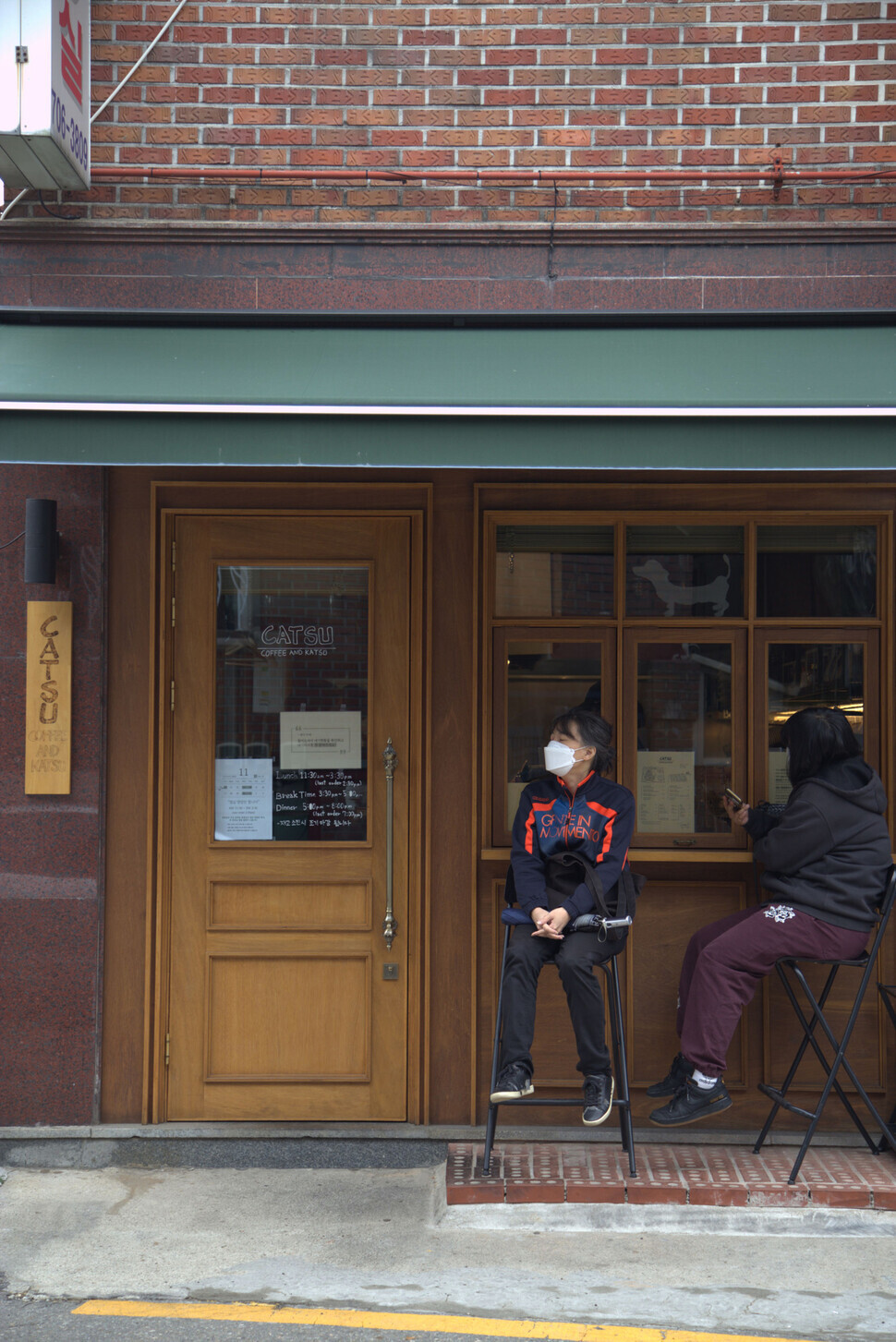
“My parents like it too.” This was the explanation from a younger customer who was getting some tonkatsu for takeaway while they were dining on a tenderloin set at Catsu.
That’s another of tonkatsu’s strong points: everyone likes it. Some of the foods that young people dig today are less popular among older eaters with their flavoring and unusual appearance. There are also other foods that older people love but younger people don’t really seek out.
Tonkatsu isn’t one of those — a fact that the data bear out.
“Tonkatsu restaurants have a particularly high repeat ordering rate,” said a source with one delivery service app, speaking on condition of anonymity.
“I’m not sure why it is, but the people who order the tonkatsu always order the tonkatsu. I’ve even heard developers asking us to up our tonkatsu marketing.”
“Not sure why”? It’s because everyone loves tonkatsu.
Like deeply rooted trees, tonkatsu restaurants with staying power aren’t bothered by the winds of the times. An example of this is Katsuya, located in the Mugyo neighborhood of central Seoul’s Jung District.
Mugyo is considered one of Seoul’s premier commercial areas catering to office workers. Demand spikes heavily around lunchtime, and many restaurants don’t open at all on non-workdays.
According to Katsuya’s owner, Sim Bong-seop, sales in this area didn’t suffer too much of a hit even when the COVID-19 pandemic had almost everyone working from home. The number of delivery and take-out orders rose to match the decline in customers dining in.
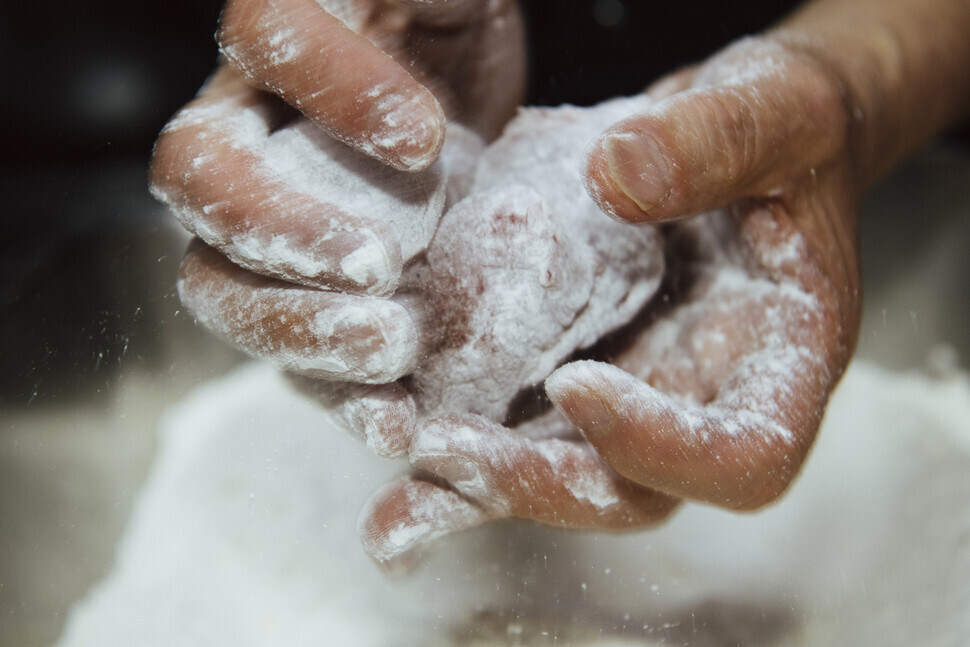
Katsuya is another example where the secret to that staying power lies in the flavor. Sim trained in Japan at Horaiya, a tonkatsu restaurant boasting a history dating back a century.
Katsuya’s flavor, success, and ethic are symbols of interchange between Korea and Japan. Sim first became aware of the wonders of tonkatsu while living in Japan for his employment in the 1990s. An acquaintance helped arrange for him to study at a renowned tonkatsu restaurant.
While he was there, Sim learned an important lesson: “Stay away from gimmicks.” It’s a lesson he continues to uphold.
Katsuya’s tonkatsu is made as soon as the order comes in. Salt and pepper are applied while the meat is still raw. A thin layer of flour is added, followed by egg and breadcrumbs. Once you fry it at 170 degrees, it becomes Katsuya’s signature filet katsu.
“Making tonkatsu is very simple,” Sim commented. Doing something simple without playing tricks for 30 years is no easy feat.
What’s more is that its flavor wows diners. The quality of the freshly fried, lightly seasoned meat sings through with each bite. The cutlets are battered to perfection and fried up crisp.
Asking whether Katsuya’s tonkatsu, a food which has its roots in Japan, should be categorized as Japanese cuisine or Korean cuisine is anachronistic. As I write this article, it’s become clear to me that tonkatsu is a modern Korean food that has been influenced by many different places.
Japanese tonkatsu is itself an improvement based on Western pork cutlets. Katsuya’s Shim Bong-seop, who learned the recipe from Japan, sells “tonkatsu tofu kimchi,” a recipe in which tofu and kimchi is served next to tonkatsu.
It’s a great example of fusion Korean snacks. Much like how the Eulji branch of Bier Halle serves schweinshaxe (German pig’s leg) with leek kimchi.
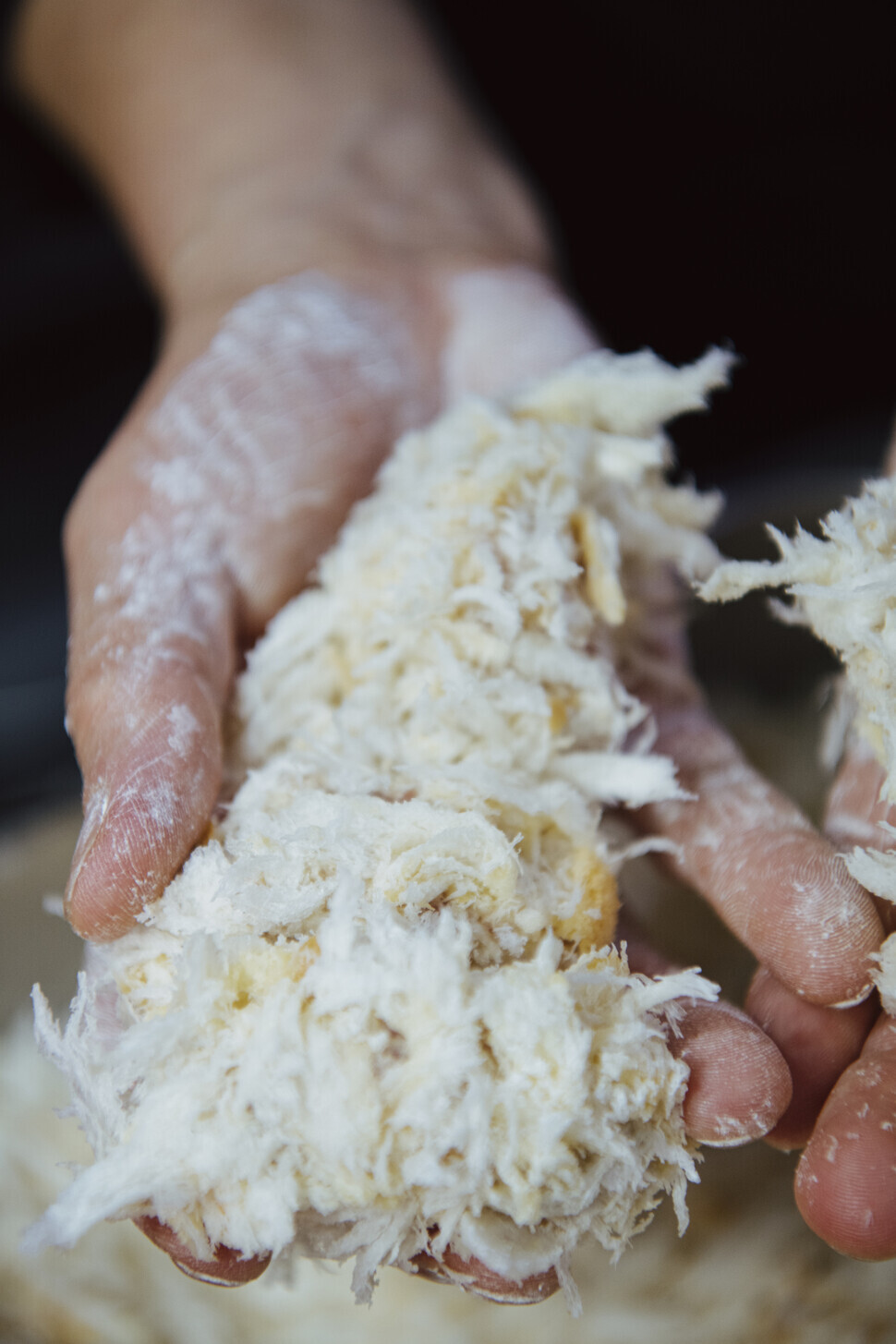
“Japanese tonkatsu and Korean tonkatsu are two very different meals,” said Lee Geon-woo, 39, a translator who has published a book on tonkatsu.
Lee has lived in Japan, but he never intended to write a book on tonkatsu. Since he enjoyed writing about food, he chose a certain food to keep a record of. For many years, he regularly posted about tonkatsu restaurants he visited. The fruit of his labor was published into a book in Korean this October, under the title “Chasing Tonkatsu: An Adventure.”
Exploring how Lee thought to pick tonkatsu as the subject of writing is interesting. After he thought of tteokbokki, sundaeguk (blood sausage soup), and tonkatsu, he finally decided on tonkatsu.
“Information on tteokbokki is already pretty widespread, especially in Internet communities. Sundaeguk seemed to have less variety between different restaurants.”
In summary, when one considered the universality of the menu, the individual style of restaurants, and the total number of stores that had that specific menu, tonkatsu was the one dish that seemed appropriate as the subject of a one-menu food review.
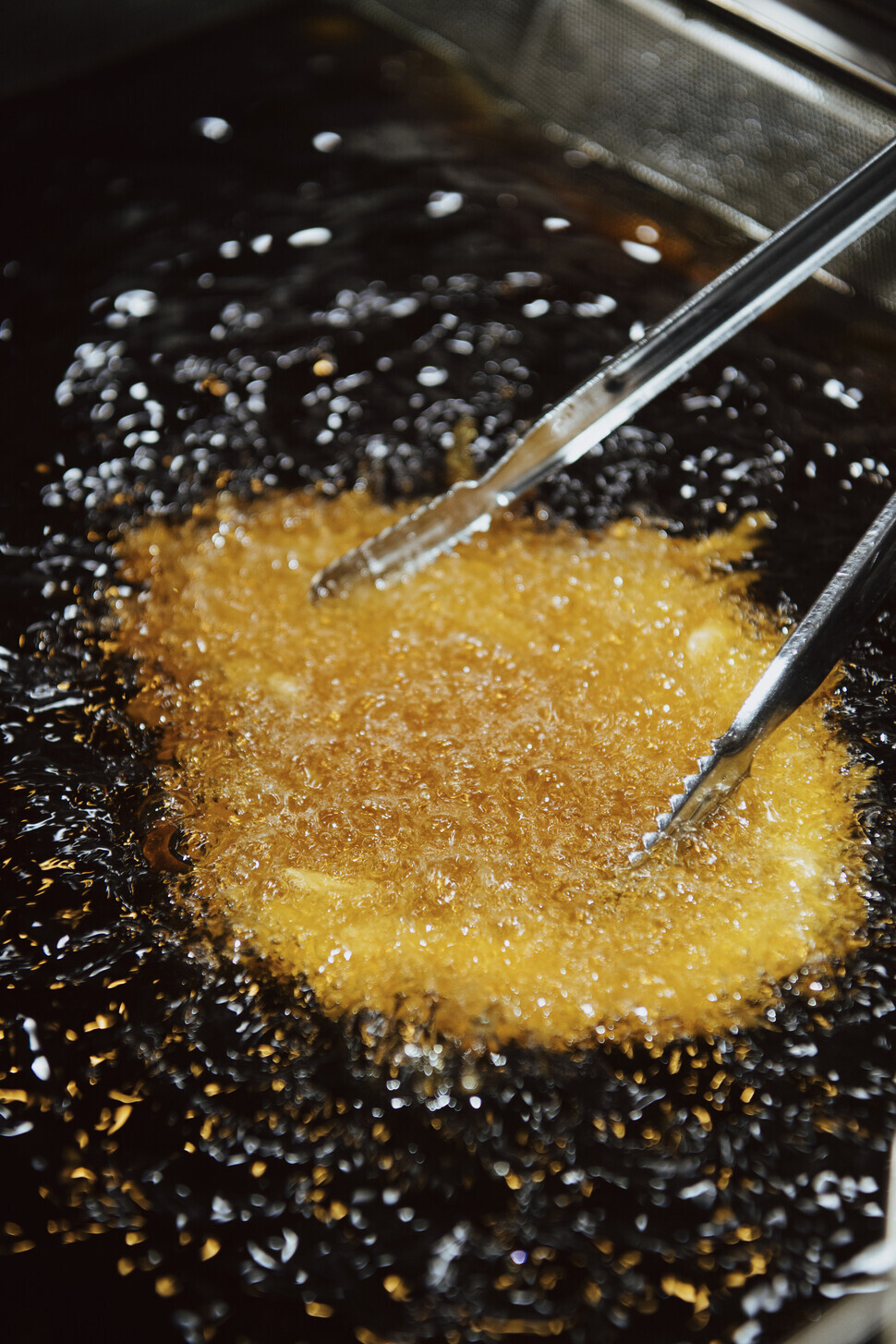
This makes sense. You can see both the individuality of the shop’s owner and the commonality that tonkatsu has as a fried meat dish in various tonkatsu restaurants.
As a result, exploring tonkatsu becomes a unique Korean gourmet experience that cannot be found anywhere else in the world. Gourmet dining is not exclusive to expensive dishes that one gloats over. Don’t you think that eating a well-made dish slowly while savoring every bite also constitutes a gourmet experience?
Hangwoon Donkatsu — literally “lucky tonkatsu” — in the Jangan neighborhood of Seoul’s Dongdaemun District is a place that makes you think about what a Korean tonkatsu is. The tonkatsu here look like that of any other Korean tonkatsu restaurant.
When you order the set meal, you get served a big plate stacked with tonkatsu, fish cutlets, a small round mound of rice, and a bowl of soup.
Everything in this restaurant’s combo has its own detailed history. This is a go-to hole in the wall for locals of the neighborhood. The first owner, the father of the current owner, became popular for frying big cuts of meat and serving it with kkakdugi, a type of radish kimchi normally sold at seolleongtang ox bone soup restaurants.
To cut down on the greasiness of the tonkatsu, Hangwoon doesn’t coat their meat in flour, but only dredges it in egg before frying. The rice is shaped in a perfectly round shape because the rice is measured with an ice cream scoop.
This tradition has been continued on, so that the second owner Jung Jae-hoon has not changed anything to affect the flavor of the tonkatsu, even after studying food abroad in Canada.
As a result, people line up outside this restaurant before it opens at 10:30 am to have breakfast alone.
Wrapping up the year victoriousIs there a particular reason people eat tonkatsu at the end of the year? Here are a few possible explanations.
“The ‘katsu’ in tonkatsu means ‘to win’ in Japanese. They say that’s why they eat tonkatsu before exams or an important event. In that vein, what’s stopping us from having tonkatsu at the end of the year, thinking that we’ve wrapped up yet another victorious year?” Those are the words of Lee Geon-woo.
I would like to add on to that. You should never need an excuse to eat good food.
You can have it for lunch or for dinner, for a meal or for a snack to go with a drink. It goes well with both beer and soju, so why not wrap up the end of the year with some tonkatsu?
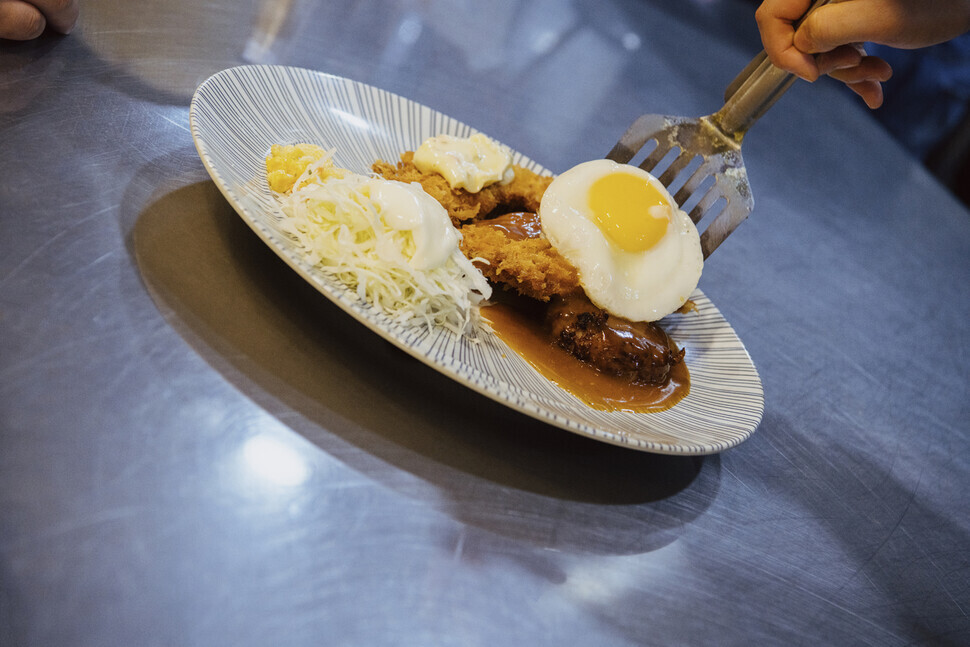
Here we will introduce tonkatsu restaurants that were mentioned in this article as well as places that have been recommended by the author of “Chasing Tonkatsu: An Adventure.”
Tonkatsu that has turned into basically Korean cuisine, massive tonkatsu that you will be able to find in at least one place in your neighborhood, tonkatsu that shows how upgraded Korean cuisine has gotten — all of these will be introduced.
Visiting the restaurants introduced in this article might be interesting, but it might also be fun to go to your neighborhood tonkatsu restaurant to see how different and unique that restaurant is.
•Katsuya — A tonkatsu restaurant that shows how a recipe learned from Japan can turn itself local. With skills learned from a tonkatsu place in Ueno, Japan, this restaurant only fries the pork right after they get each individual order; as soon as an order comes in, the pork is covered in flour and fried.
It also makes its own soybean paste soup by mixing several pastes, showing how much the chef pays attention to the taste of the food.
As a lot of effort is put into frying the pork, the owner recommends that one sprinkles the sauce lightly on top, rather than dipping the tonkatsu in the sauce. Sells alcohol in the evening.
Location: First floor of 46 Dadong-gil, Jung-gu, Seoul. Hirekatsu set priced at 13,000 won.
•Hangwoon Tonkatsu — A typical Korean tonkatsu restaurant that looks like it’ll be in every neighborhood, or the kind of restaurant you wish was in every neighborhood. The cutlets are big, according to Korean tradition, so there’s more than enough to go around.
Since it’s only coated in egg, instead of the usual flour and egg batter, it manages to be relatively less greasy for its large size. 25 liters of sauce is used every day, showing the quick rotation of ingredients, which also indicates stable service.
Location: 173 Janghan-ro, Dongdaemun-gu, Seoul. Hangwoon set priced at 11,000 won.
•Catsu — An interesting tonkatsu restaurant as it is a place where you can get both high quality tonkatsu and coffee. Run by a married couple, the husband makes the tonkatsu, and the wife makes the coffee.
The quality of the food in general is very high, as can be seen from the sirloin katsu and filet katsu, which are all made with good ingredients and are fried just right.
The fact that you can have katsu sandwiches and coffee is something that can be highly appreciated.
Location: On the first floor’s left side of 58 Dokmak-ro 28-gil, Mapo-gu, Seoul. Sirloin katsu set priced at 14,000 won.
•Sagaru Katsu — I asked Lee Geon-woo whether there was “a tonkatsu place that had a memorable signature menu.” One of the two places he recommended was “Sagaru Katsu,” located in Jung District, Seoul.
Run by the owner of a tuna hoe (raw fish) restaurant, they make raw tuna into fish katsu. They also serve a katsu collection for big eaters, which includes fish katsu, sirloin katsu, and filet katsu.
Location: Dasan-ro 114-1, Jung-gu, Seoul. Fish katsu priced at 9,000 won.
•Tori Tonkatsu — Another restaurant Lee pointed out is Tori Tonkatsu, located in Seongbuk District, Seoul.
Their unique “pasta cheese tonkatsu” is like a croquette — pasta and cheese are enveloped in meat, and then fried.
When you cut the tonkatsu in half, tomato-sauce-covered fusilli and cheese come gushing out. In addition to the “pasta cheese tonkatsu,” they have a substantial menu full of various tonkatsu and pasta.
Location: Second floor of 24 Hwarang-ro 13-gil, Seongbuk-gu, Seoul.
By Park Chan-yong, columnist
Please direct questions or comments to [english@hani.co.kr]

Editorial・opinion
![[Editorial] Yoon must halt procurement of SM-3 interceptor missiles [Editorial] Yoon must halt procurement of SM-3 interceptor missiles](https://flexible.img.hani.co.kr/flexible/normal/500/300/imgdb/child/2024/0501/17145495551605_1717145495195344.jpg) [Editorial] Yoon must halt procurement of SM-3 interceptor missiles
[Editorial] Yoon must halt procurement of SM-3 interceptor missiles![[Guest essay] Maybe Korea’s rapid population decline is an opportunity, not a crisis [Guest essay] Maybe Korea’s rapid population decline is an opportunity, not a crisis](https://flexible.img.hani.co.kr/flexible/normal/500/300/imgdb/original/2024/0430/9417144634983596.jpg) [Guest essay] Maybe Korea’s rapid population decline is an opportunity, not a crisis
[Guest essay] Maybe Korea’s rapid population decline is an opportunity, not a crisis- [Column] Can Yoon steer diplomacy with Russia, China back on track?
- [Column] Season 2 of special prosecutor probe may be coming to Korea soon
- [Column] Park Geun-hye déjà vu in Yoon Suk-yeol
- [Editorial] New weight of N. Korea’s nuclear threats makes dialogue all the more urgent
- [Guest essay] The real reason Korea’s new right wants to dub Rhee a founding father
- [Column] ‘Choson’: Is it time we start referring to N. Korea in its own terms?
- [Editorial] Japan’s rewriting of history with Korea has gone too far
- [Column] The president’s questionable capacity for dialogue
Most viewed articles
- 1Months and months of overdue wages are pushing migrant workers in Korea into debt
- 2Trump asks why US would defend Korea, hints at hiking Seoul’s defense cost burden
- 3At heart of West’s handwringing over Chinese ‘overcapacity,’ a battle to lead key future industries
- 4[Editorial] Yoon must halt procurement of SM-3 interceptor missiles
- 5Fruitless Yoon-Lee summit inflames partisan tensions in Korea
- 6Dermatology, plastic surgery drove record medical tourism to Korea in 2023
- 71 in 3 S. Korean security experts support nuclear armament, CSIS finds
- 8AI is catching up with humans at a ‘shocking’ rate
- 9First meeting between Yoon, Lee in 2 years ends without compromise or agreement
- 10[Guest essay] Maybe Korea’s rapid population decline is an opportunity, not a crisis